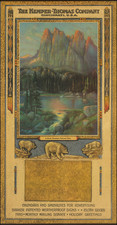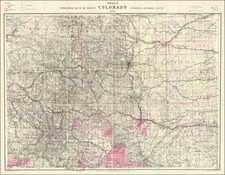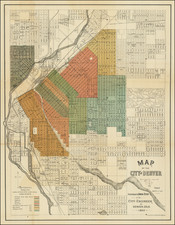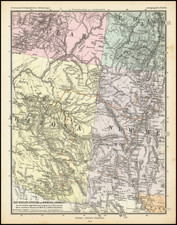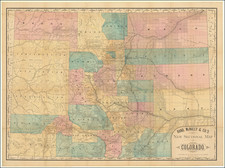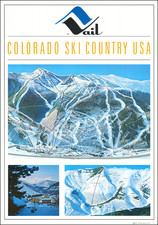Gunnison Surveys in Western Colorado in 1853
Important early sketch map of the area from the Colorado Rocky Mountains to the Grand Junction area and Northwestern Utah.
Centered on the headwaters of the Arkansas River (flowing east) and the Grand River (flowing west), the map captures the Continental Divide and highest of Colorado's peaks in a remarkable overview.
The map covers the early surveys in search of prospective routes for the Transcontinental Railroad, and would serve as a precursor for the Gunnison & Beckwith map (TMW #842) of the area from St. Louis to San Francisco. The present map is on a much larger scale, showing Gunnison's route from the Arkansas River valley through the modern La Vita Pass, Garland, Gunnison and the vicinity of Grand Junction. The last camp shown on the map is dated September 20th, 1853. Five weeks, later Gunnison and Kern were killed near Siever Lake, Utah.
This map was issued in the scarce, preliminary octavo edition of the Pacific Railroad Surveys that preceded the quarto edition by over a year.
Gunnison-Beckwith Expedition
On May 3, 1853, Captain John Williams Gunnison was ordered to lead an expedition to survey a route for a Pacific railroad between the 38th and 39th parallels. The surveying party left St. Louis, Missouri, in June 1853 and arrived by mid-October in Manti, Utah Territory. In Utah Territory, with Lieutenant E. G. Beckwith as assistant commander, Gunnison began the survey of a possible route, surveying areas across the Rocky Mountains via the Herfano River, through Cochetopa Pass, and by way of the present Gunnison and Green rivers to the Sevier River. His journey took him through the Tomichi Valley in Colorado, where the town of Gunnison is named in his honor. After crossing the Tomichi Valley, the survey team encountered the Black Canyon, carved by the Gunnison River which was also named in his honor. The team was forced to turn South to get around the canyon.
The weather was beginning to turn "cold and raw" with snow flurries and Captain Gunnison sought to speed up mapping before returning to winter quarters. At Lake Sevier, the team was divided into two detachments. On the morning of October 26, 1853, Gunnison and the eleven men in his party were attacked by a band of Pahvants (Ute) and Gunnison and seven others were killed. Killed with Gunnison were Richard H. Kern (topographer and artist), F. Creuzfeldt (botanist), Wiliam Potter (a Mormon guide), Private Caulfield, Private Liptoote, Private Mehreens, and John Bellows (camp roustabout.).
Most contemporary accounts provide that the Mormons warned Gunnison that his party might be in danger from local bands of Pahvant Utes. It seems that Gunnison had entered Utah in the midst of the Walker War, between the Mormons and the Ute Chief Walkara. Lt. Beckwith later wrote that the expedition found the local Mormons "all gathered into a village for mutal protection against the Utah Indians." Late, rumors circulated that the Pahvants were acting under the direction of Brigham Young and an alleged secret militia known as the Danites. Some claim that leaders of The Church of Jesus Christ of Latter-day Saints were initially concerned that the railway would increase the influx of non-Mormon settlers and non-Mormon economic concerns into the territory. However, the Utah Legislature (dominated by LDS officials) had repeatedly petitioned Congress for both a transcontinental railroad and telegraph lines to pass through the region. When the railroad finally came to Utah, LDS leaders organized cadres of Mormon workers to build the railway, welcoming the income for the economically depressed settlers.
Martha Gunnison, widow of Captain Gunnison, was one of those who maintained that the attack was planned and orchestrated by militant Mormons under the direction of Brigham Young. Gunnison's letters to his wife throughout the expedition left her with the impression that "the Mormons were the directors of my husband's murder." She wrote to Associate Justice W.W. Drummond, the 1855 federal appointee to the Supreme Court of the Territory of Utah. She received confirmation of this belief in his response to her letter. Drummond drew this conclusion from informant and witness testimonies in several trials after the murders. He cited numerous reports by whites and natives of white attackers dressed up as Indians during the massacre.
However, Lt. Beckwith concluded that the Mormons had nothing to do with the attack. He wrote in his official report that the "statement which has from time to time appeared (or been copied) in various newspapers...charging the Mormons or Mormon authorities with instigating the Indians to, if not actually aiding them in, the murder of Captain Gunnison and his associates, is, I believe, not only entirely false, but there is no accidental circumstance connected with it affording the slightest foundation for such a charge."
Nevertheless, the Gunnison Massacre resulted in much controversy and added additional strain to the relationship between Governor Brigham Young of the Utah Territory and the Federal Government. This incident and related events, including the Mountain Meadows massacre, where Mormons killed over 100 settlers of the Baker-Fancher wagon train, eventually culminated in the Utah War, wherein President Buchanan sent the U.S. Army to the Utah Territory in order to stop a reported Mormon insurrection.









